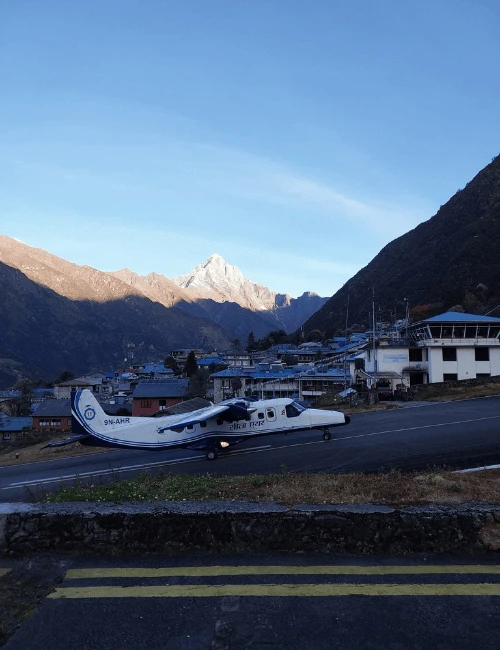Embarking on the trek to Annapurna Base Camp (ABC) is a thrilling adventure filled with breathtaking landscapes, challenging terrain, and unforgettable experiences. As you prepare for this epic journey through the heart of the Annapurna region, navigation is one essential aspect that demands careful consideration.
Navigating the Trail: Must Have Navigation Tools for ABC Trek
Embarking on the trek to Annapurna Base Camp (ABC) is a thrilling adventure filled with breathtaking landscapes, challenging terrain, and unforgettable experiences. As you prepare for this epic journey through the heart of the Annapurna region, navigation is one essential aspect that demands careful consideration.
Navigating the trails of the ABC trek requires more than just a sense of adventure; it requires proper preparation and the right navigation gear to ensure a safe and enjoyable experience. In this comprehensive guide, we'll explore the must-have navigation gear that every trekker should consider before setting foot on the trail.
From traditional tools like compasses and maps to modern GPS devices and mobile apps, we'll cover everything you need to know to navigate confidently through the diverse landscapes of the Annapurna region. Whether you're a seasoned trekker or embarking on your first Himalayan adventure, this guide will equip you with the knowledge and resources to navigate the ABC trek with ease.
Join us as we delve into the world of trekking navigation gear and discover how these essential tools can enhance your journey to Annapurna Base Camp. Get ready to embark on the adventure of a lifetime and navigate the trail like a seasoned explorer.
Compass and Map
As you prepare for your trek to Annapurna Base Camp (ABC), one of the most critical pieces of navigation gear you'll need is a reliable compass and map. Trekkers have trusted these traditional tools for generations and remain essential for route planning and orientation in the rugged terrain of the Annapurna region.
A compass is a simple yet invaluable tool that helps you determine direction and maintain your bearings on the trail. By aligning the compass needle with the map's north-south grid lines, you can accurately identify your current location and plot a course to your destination. This is especially useful in areas where trail markings may be sparse or obscured by natural obstacles.
Accompanying the compass, a topographic map provides a detailed representation of the terrain, including elevation contours, water features, and landmarks. By studying the map before your trek and familiarizing yourself with key landmarks and trail junctions, you can better navigate the route and anticipate upcoming challenges.
When selecting a compass and map for your ABC trek, opt for models that are durable, waterproof, and easy to read. Consider investing in a sighting compass, which allows for more precise navigation by sighting distant landmarks and taking accurate bearings. Additionally, choose a topographic map specifically designed for trekking in the Annapurna region, ensuring it includes relevant trails, campsites, and points of interest.
During your trek, regularly reference your compass and map to stay on course and track your progress along the trail. Pay attention to prominent landmarks, such as peaks, rivers, and villages, to confirm your position and adjust your route as needed. By mastering the use of these traditional navigation tools, you'll gain confidence and independence as you explore the breathtaking landscapes of the ABC trek.
GPS Devices
In addition to traditional navigation tools like compasses and maps, modern GPS devices have revolutionized the way trekkers navigate through challenging terrain, including the Annapurna Base Camp (ABC) trek. These advanced devices offer precise location tracking, detailed mapping features, and valuable navigational data that enhance your ability to navigate effectively on the trail.
One of the primary advantages of using a GPS device for navigation is its accuracy and reliability in determining your exact location. With satellite technology, GPS devices can provide real-time positioning information, allowing you to track your progress along the trail with confidence. This is particularly useful in remote areas where trail markings may be scarce, or visibility is limited due to weather conditions.
Furthermore, GPS devices offer detailed mapping functionalities that can help you plan your route, identify key landmarks, and anticipate upcoming challenges on the trail. Many GPS devices come preloaded with topographic maps and trail data specific to the Annapurna region, providing you with essential information about elevation changes, water sources, and points of interest along the route.
When selecting a GPS device for your ABC trek, consider factors such as battery life, durability, and ease of use. Look for devices with long-lasting battery performance to ensure they can withstand extended treks without needing frequent recharging. Additionally, opt for models that are rugged and weather-resistant to withstand the rigors of outdoor use in mountainous terrain.
In addition to standalone GPS devices, many trekkers also rely on smartphone apps with GPS functionality for navigation on the trail. These apps offer similar features to dedicated GPS devices, including real-time tracking, offline mapping, and waypoint marking. While smartphone apps can be a convenient and cost-effective alternative, be mindful of remote areas' battery life and network coverage limitations.
Whether you choose a dedicated GPS device or a smartphone app for navigation, make sure to familiarize yourself with its features and practice using it before your trek. By incorporating GPS technology into your navigation toolkit, you'll enhance your safety, confidence, and enjoyment as you explore the stunning landscapes of the Annapurna Base Camp trek.
Trail Markers and Signposts
As you trek through the Annapurna region en route to Annapurna Base Camp (ABC), you'll encounter a network of trail markers and signposts that guide you along the path. These visual cues play a crucial role in navigation, helping you stay on course and navigate safely through the diverse terrain of the ABC trek.
Trail markers come in various forms, including painted symbols on rocks, wooden signposts, and cairns (stacked stones), each serving as indicators of the established trail. These markers are strategically placed at key junctions, trail intersections, and points of interest along the route, providing reassurance and direction to trekkers as they progress through the landscape.
Signposts, on the other hand, offer more detailed information about trail conditions, distances to landmarks, and points of interest along the route. Typically made of wood or metal, signposts feature directional arrows, distance markers, and trail names, helping trekkers navigate confidently and make informed decisions about their route.
Throughout your ABC trek, keep a lookout for trail markers and signposts, especially in areas where the trail may be less defined or obscured by natural obstacles. Follow the painted symbols, arrows, and directional signs to stay on the designated route and avoid getting lost or off-track.
In addition to official trail markers and signposts, you may also encounter informal markers created by previous trekkers, such as cairns or stacked stones. While these markers can be helpful in some cases, exercise caution and verify their reliability before relying on them for navigation, as they may not always indicate the correct route.
As you navigate the trail, use trail markers and signposts as reference points to confirm your location and progress along the route. Pay attention to any changes in trail markings or signage, as they may indicate upcoming turns, junctions, or points of interest along the way.
By staying vigilant and observant of trail markers and signposts, you'll enhance your navigation skills and confidence as you journey through the stunning landscapes of the Annapurna Base Camp trek.
Mobile Apps for Navigation
In today's digital age, trekkers have access to a wide range of mobile apps that serve as powerful navigation tools for the Annapurna Base Camp (ABC) trek. These apps offer convenient and accessible solutions for route planning, GPS tracking, and real-time navigation, enhancing your ability to navigate confidently on the trail.
One of the primary advantages of using mobile apps for navigation is their versatility and portability. With a smartphone or tablet, you can carry a wealth of navigational information in the palm of your hand, including offline maps, GPS tracking, and trail data specific to the Annapurna region. This allows you to navigate the trail with ease, even in remote areas where network coverage may be limited.
Many mobile apps designed for trekking and outdoor adventures offer offline mapping functionality, allowing you to download maps for offline use and navigate without relying on a cellular or Wi-Fi connection. This is particularly useful in remote areas like the Annapurna region, where network coverage may be unreliable or non-existent.
In addition to offline maps, mobile apps often feature GPS tracking capabilities that allow you to track your location in real time and navigate along the designated route. Some apps also offer waypoint marking, route recording, and elevation profiling features, providing valuable navigational data to enhance your trekking experience.
When choosing a mobile app for navigation on the ABC trek, look for apps that are specifically designed for outdoor navigation and offer comprehensive features tailored to trekking and hiking. Popular apps like Gaia GPS, AllTrails, and ViewRanger are trusted by outdoor enthusiasts worldwide and provide reliable navigation solutions for the Annapurna region.
Before your trek, download your chosen navigation app and familiarize yourself with its features and functionality. Practice using the app to plan routes, mark waypoints, and track your progress along the trail, ensuring you're comfortable with its interface and capabilities before setting out on your ABC trek.
By harnessing the power of mobile apps for navigation, you'll have a valuable tool at your fingertips to help you navigate confidently and safely through the breathtaking landscapes of the Annapurna Base Camp trek.
Emergency Navigation Techniques
While modern navigation tools like GPS devices and mobile apps provide valuable assistance on the trail, it's essential to be prepared for unexpected challenges or equipment failures during your trek to Annapurna Base Camp (ABC). Familiarizing yourself with emergency navigation techniques can help you stay on course and find your way in difficult situations.
One of the simplest and most reliable emergency navigation techniques is using natural landmarks to orient yourself and determine direction. Mountains, rivers, and prominent rock formations can serve as reliable reference points, helping you maintain a sense of direction even if you're temporarily disoriented.
In addition to natural landmarks, celestial cues such as the sun, moon, and stars can provide valuable navigation information, especially when visibility is limited or when navigating at night. Learn how to use the position of the sun or the North Star to determine cardinal directions, allowing you to navigate with confidence even in challenging conditions.
If you find yourself without access to traditional navigation tools like compasses or maps, rely on your observational skills and knowledge of the surrounding terrain to guide your way. Look for distinctive features or landmarks that you can recognize from your surroundings, such as mountain peaks, rivers, or valleys, and use them to navigate toward your destination.
In case of emergency, it's also essential to have a basic understanding of map and compass navigation techniques. Practice orienting a map using prominent landmarks and taking bearings with a compass to determine your direction of travel. These fundamental skills can be invaluable in helping you find your way back to safety if you become lost or disoriented on the trail.
Before embarking on your ABC trek, take the time to familiarize yourself with emergency navigation techniques and practice them in a controlled environment. By being prepared for unexpected challenges and equipped with the knowledge and skills to navigate effectively, you can ensure a safe and successful trekking experience in the Annapurna region.
Conclusion
As you prepare to embark on your trek to Annapurna Base Camp (ABC), it's crucial to equip yourself with the necessary navigation gear and skills to ensure a safe and successful journey. From traditional tools like compasses and maps to modern GPS devices and mobile apps, each piece of navigation equipment plays a vital role in helping you navigate through the diverse terrain of the Annapurna region.
By investing in reliable navigation gear and familiarizing yourself with navigation techniques, you'll be better prepared to navigate confidently on the trail and overcome any challenges that may arise during your trek. Whether you're following trail markers, using GPS technology, or relying on emergency navigation techniques, having the right tools and knowledge at your disposal will enhance your safety, confidence, and enjoyment as you explore the stunning landscapes of the ABC trek.
Remember to plan, stay informed about trail conditions, and respect the natural environment as you trek through the Annapurna region. By practicing Leave No Trace principles and being mindful of your impact on the landscape, you can help preserve the beauty and integrity of the ABC trek for future generations of trekkers to enjoy.
As you set out on your adventure to Annapurna Base Camp, may your journey be filled with breathtaking views, memorable experiences, and safe travels. Happy trekking!
"Discover essential navigation gear for your trek to Annapurna Base Camp (ABC). Learn about compasses, maps, GPS devices, and mobile apps for navigating the rugged terrain of the Annapurna region. Stay on course with expert tips and emergency navigation techniques. Get ready for the adventure of a lifetime with must-have gear for the ABC trek."
FAQs
What navigation gear do I need for trekking to Annapurna Base Camp?
For trekking to Annapurna Base Camp, essential navigation gear includes a compass, map, GPS device or smartphone with navigation apps, and emergency navigation tools.
How do I choose the right compass and map for the ABC trek?
Choose a reliable compass with a sighting mirror and declination adjustment for accurate navigation. Opt for topographic maps specifically designed for the Annapurna region, highlighting trails, landmarks, and elevations.
Can I rely on GPS devices for navigation in the Annapurna region?
GPS devices are valuable navigation tools but should be used as a complement to traditional methods. Ensure your GPS device has preloaded maps and consider carrying spare batteries or a portable charger.
What are the benefits of using mobile apps for navigation on the ABC trek?
Mobile apps offer convenience, offline mapping, and GPS tracking functionalities. They provide real-time navigation assistance and can be used to plan routes, mark waypoints, and track progress.
Are there offline maps available for the Annapurna Base Camp route?
Yes, many navigation apps offer offline maps that can be downloaded before the trek. These offline maps provide access to navigation data even in areas with limited or no network coverage.
How do I interpret trail markers and signposts along the trail?
Trail markers and signposts indicate trail directions, distances, and points of interest. Follow painted symbols, arrows, and directional signs, and consult trail maps for additional guidance.
What should I do if I get lost on the ABC trek?
Stay calm and retrace your steps to the last known location. Use navigation tools, landmarks, and natural features to orient yourself. If necessary, seek assistance from fellow trekkers or local guides.
Are there emergency navigation techniques I should know about?
Emergency navigation techniques include using natural landmarks, celestial cues, and basic map and compass skills. Practice these techniques before the trek and carry emergency navigation aids.
What are the most common challenges in navigation on the ABC trek?
Common challenges include variable weather conditions, rugged terrain, and limited visibility. Be prepared for changing circumstances and adapt navigation strategies accordingly.
How do I prepare for navigation in remote and mountainous terrain?
Familiarize yourself with navigation tools and techniques, plan routes in advance, and carry adequate navigation gear. Stay informed about trail conditions and be prepared for unexpected challenges.




.webp)

